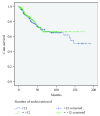Clinicopathological Factors Influencing Lymph Node Yield in Colorectal Cancer: A Retrospective Study
- PMID: 30804995
- PMCID: PMC6362492
- DOI: 10.1155/2019/5197914
Clinicopathological Factors Influencing Lymph Node Yield in Colorectal Cancer: A Retrospective Study
Abstract
Many colorectal resections do not meet the minimum of 12 lymph nodes (LNs) recommended by the American Joint Committee on Cancer for accurate staging of colorectal cancer. The aim of this study was to investigate factors affecting the number of the adequate nodal yield in colorectal specimens subject to routine pathological assessment. We have retrospectively analysed the data of 2319 curatively resected colorectal cancer patients in San Raffaele Scientific Institute, Milan, between 1993 and 2017 (1259 colon cancer patients and 675 rectal cancer patients plus 385 rectal cancer patients who underwent neoadjuvant therapy). The factors influencing lymph node retrieval were subjected to uni- and multivariate analyses. Moreover, a survival analysis was carried out to verify the prognostic implications of nodal counts. The mean number of evaluated nodes was 24.08 ± 11.4, 20.34 ± 11.8, and 15.33 ± 9.64 in surgically treated right-sided colon cancer, left-sided colon cancer, and rectal tumors, respectively. More than 12 lymph nodes were reported in surgical specimens in 1094 (86.9%) cases in the colon cohort and in 425 (63%) cases in the rectal cohort, and patients who underwent neoadjuvant chemoradiation were analysed separately. On univariate analysis of the colon cancer group, higher LNs counts were associated with female sex, right colon cancer, emergency surgery, pT3-T4 diseases, higher tumor size, and resected specimen length. On multivariate analysis right colon tumors, larger mean size of tumor, length of specimen, pT3-T4 disease, and female sex were found to significantly affect lymph node retrieval. Colon cancer patients with 12 or more lymph nodes removed had a significantly better long-term survival than those with 11 or fewer nodes (P = 0.002, log-rank test). Rectal cancer patients with 12 or more lymph nodes removed approached but did not reach a statistically different survival (P = 0.055, log-rank test). Multiple tumor and patients' factors are associated with lymph node yield, but only the removal of at least 12 lymph nodes will reliably determine lymph node status.
Figures



References
-
- Compton C. C., Fielding L. P., Burgart L. J., Conley B., Cooper H. S., Hamilton S. R., et al. Prognostic factors in colorectal cancer. College of American Pathologists Consensus Statement 1999. Archives of Pathology & Laboratory Medicine. 2000;124:979–994. doi: 10.1043/0003-9985(2000)124<0979:PFICC>2.0.CO;2. - DOI - PubMed
-
- Goldstein N. S. Lymph node recoveries from 2427 pT3 colorectal resection specimens spanning 45 years: recommendations for a minimum number of recovered lymph nodes based on predictive probabilities. The American Journal of Surgical Pathology. 2002;26(2):179–189. doi: 10.1097/00000478-200202000-00004. - DOI - PubMed
LinkOut - more resources
Full Text Sources
Other Literature Sources

